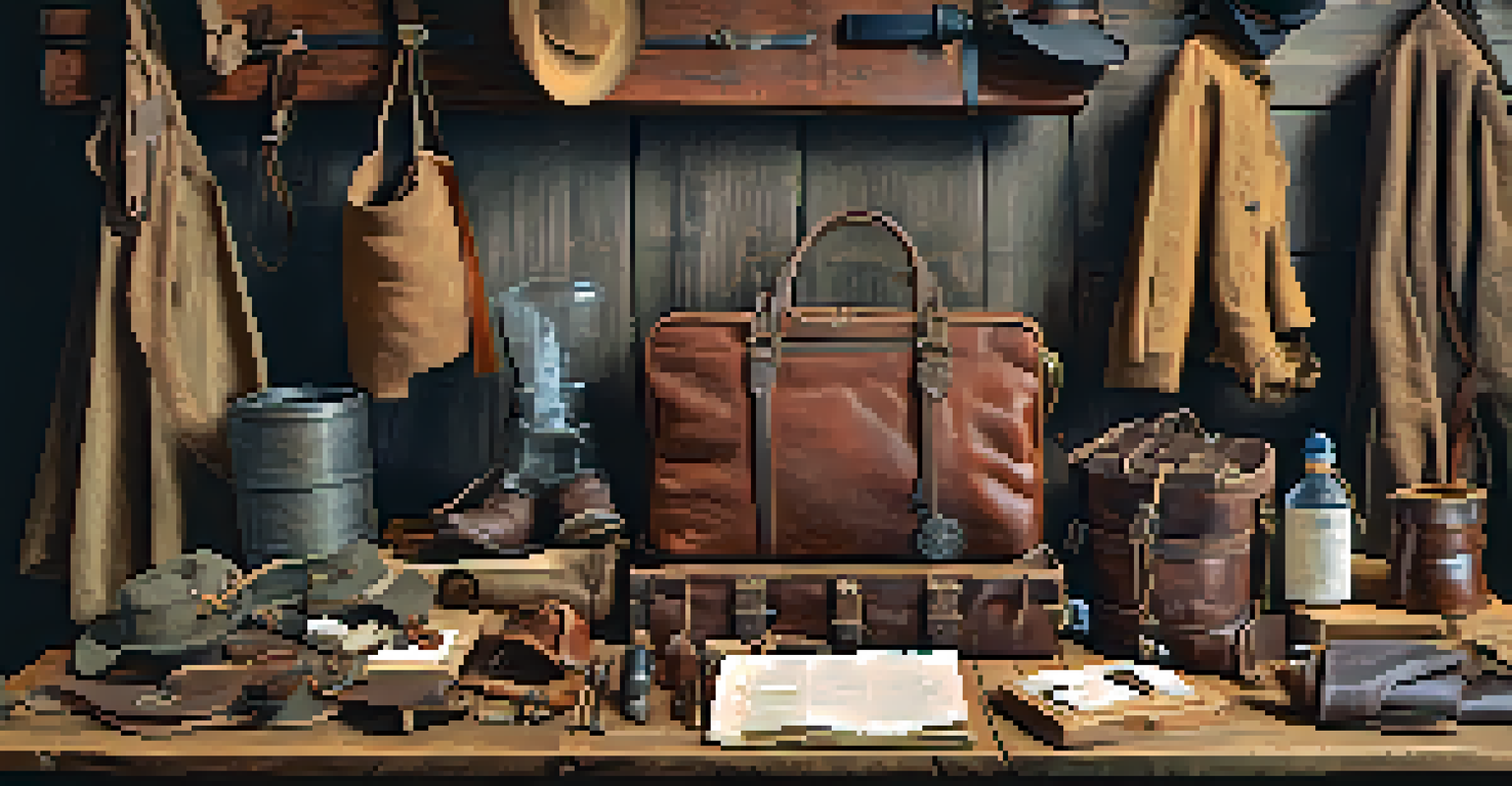Setting Up Your Reenactment Gear: Essentials to Pack

Understanding the Importance of Proper Gear Setup
When it comes to reenactments, having the right gear can make or break your experience. Proper gear not only enhances your authenticity but also ensures comfort during long hours of activity. Imagine being in the middle of a battle scene only to realize you forgot a crucial item—it's a situation best avoided!
If you don't know where you're going, any road will get you there.
Setting up your gear is like preparing for a journey; every item has its purpose and place. Just as a traveler wouldn't leave without their essentials, a reenactor should be meticulous in their preparation. The right setup allows you to immerse yourself fully in the historical context you're representing.
Moreover, being well-prepared fosters camaraderie among fellow reenactors. When everyone is equipped and ready, it elevates the overall experience, creating a sense of unity and shared purpose. So, let’s dive into the essentials that will set you up for success!
Choosing the Right Historical Clothing
The first step in your gear setup is selecting appropriate historical clothing. This choice not only reflects the time period you're portraying but also affects your comfort and mobility. For instance, a wool uniform may be suitable for winter events, while lighter fabrics are ideal for summer reenactments.

Consider the fit and layering of your clothing as well. The right layers can help you adapt to changing weather conditions, just like a seasoned backpacker knows the importance of layers in the wilderness. Don't forget to check for authenticity details, such as buttons and stitching, to ensure your attire is as accurate as possible.
Importance of Proper Gear Setup
Having the right gear enhances authenticity and comfort, making the reenactment experience more enjoyable.
Lastly, always pack an extra set of clothing. Accidents happen, whether it's mud stains or unexpected rain. Having a backup can save the day and keep you comfortable throughout the event.
Essential Personal Items to Pack
Beyond clothing, there are personal items that are crucial for a successful reenactment. Think about packing essentials like sunscreen, insect repellent, and a basic first aid kit. These items may not seem historical, but they can be lifesavers in the present day.
Preparation is the key to success.
A good pair of sturdy, comfortable shoes is also a must. Imagine marching through a field with ill-fitting footwear—painful, right? Opt for shoes that are historically accurate but also practical for walking or standing for extended periods.
Don’t forget personal hygiene items, such as biodegradable wipes and hand sanitizer. While they may not fit the historical theme, maintaining cleanliness is vital for your comfort and health during the event.
Packing Your Historical Equipment and Props
Now that you've covered your clothing and personal items, it's time to focus on your historical equipment and props. Depending on the era you're representing, this could include weapons, tools, or any artifacts relevant to your character. The right props can significantly enhance your portrayal and engagement.
When packing, ensure that your equipment is safe, particularly if it includes weapon replicas. Use protective cases or padding to prevent damage during transport. Just like a musician handles their instrument with care, treat your reenactment gear with the same respect.
Stay Hydrated and Energized
Packing reusable water bottles and high-energy snacks is essential for maintaining energy during long reenactment days.
Additionally, consider how you'll transport these items. A sturdy bag or a specialized carrying case can make a world of difference. This way, you can ensure that everything arrives intact and ready for action.
Hydration and Food: Staying Energized
Staying hydrated and energized is key during reenactments, especially with all the activity involved. Pack a reusable water bottle to keep yourself refreshed throughout the day. Hydration is not just a modern convenience; it’s essential for anyone engaged in physical activity, even in historical contexts.
For food, opt for portable, high-energy snacks like nuts, dried fruits, or energy bars. Imagine trying to stay in character while your stomach growls—definitely not ideal! A well-prepared snack can keep your spirits high and your energy levels up.
If the event allows, consider packing a historic meal to share with fellow reenactors. This not only enhances the experience but also fosters a sense of community and enjoyment. Remember, food is a shared experience that can bridge the gap between history and the present.
Weather Preparedness: Dressing for the Elements
Weather can be unpredictable, so it’s essential to prepare for various conditions. Check the forecast leading up to the event and pack accordingly. Layering is key; you can always remove or add clothing as needed, much like a chameleon adapts to its environment.
Consider investing in historically accurate outerwear for colder conditions. A wool cloak or a sturdy coat can not only keep you warm but also enhance your historical appearance. Remember, the goal is to stay comfortable while embracing the character you’re portraying.
Organize Gear for Easy Access
Keeping your gear organized with labeled bags helps you find items quickly and reduces stress during busy events.
For rain, a waterproof poncho that resembles the period's style can be both functional and stylish. Being prepared for weather changes ensures you can fully enjoy the event, no matter what nature throws your way.
Organizing Your Gear for Easy Access
When packing your gear, organization is essential for easy access during the event. Use packing cubes or bags to separate clothing, personal items, and equipment. This method makes it easy to find what you need quickly, much like a chef organizes their kitchen for efficiency.
Labeling your bags can also save you from rummaging through everything to find a single item. A simple label can go a long way in maintaining order and reducing stress during busy reenactment days. It’s all about creating a system that works for you.

Remember to keep frequently used items near the top of your bags or in easy-to-reach pockets. This way, you can grab what you need without disrupting your entire setup, allowing for a smoother and more enjoyable experience.
Final Check: Ensuring a Successful Setup
Before heading out, take a moment to do a final check of your gear. Create a checklist of all the items you’ve packed to ensure nothing is left behind. This simple step can save you from a last-minute panic, ensuring you’re fully prepared for the event ahead.
Consider doing a trial run at home, where you can try on your clothing and gear to see how it all fits together. This practice can help you identify any adjustments you may need to make, ensuring that everything is comfortable and functional.
Finally, approach the event with a positive mindset. No matter how well you prepare, flexibility is key in reenactments. Embrace the experience, connect with fellow reenactors, and enjoy the journey through history together.